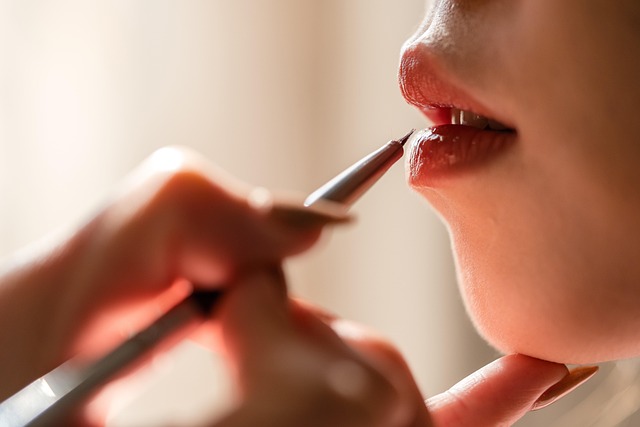In recent years, plant-based lipsticks have gained popularity due to growing consumer awareness of harmful chemicals in conventional cosmetics. These natural alternatives derive their color and moisture from fruits, vegetables, herbs, and minerals, offering ethical benefits for cruelty-free and vegan consumers. With diverse shades and formulas available, they provide long-lasting wear and comfort. Selecting a plant-based lip liner that complements skin tone is crucial for a seamless look, while strategic preparation and technique ensure flawless, lasting results.
“Discover the vibrant world of plant-based lipsticks—a revolution in natural beauty. In an era where sustainable and organic cosmetics are gaining traction, these lip products offer a fresh alternative. Our article explores the rise of plant-based lipstick and its benefits, delving into unique ingredients and their impact on skin. Learn how to choose the perfect plant-based lip liner for your skin tone and master application techniques for long-lasting, flawless color. Embrace natural beauty with our comprehensive guide.”
- Understanding Plant-Based Lipstick: The Rise of Natural Alternatives
- Benefits and Ingredients: What Makes Them Different?
- Choosing the Right Plant-Based Lip Liner for Your Skin Tone
- Application Tips and Tricks for Flawless, Long-Lasting Color
Understanding Plant-Based Lipstick: The Rise of Natural Alternatives

In recent years, there’s been a growing trend towards plant-based beauty products, and lipstick is no exception. This shift towards natural alternatives is driven by consumers’ increasing awareness of the potential harmful chemicals in conventional cosmetics. Many traditional lipsticks contain ingredients like lead, parabens, and synthetic fragrances, prompting those seeking safer options to turn to plant-based lips sticks as a more sustainable and healthy choice.
Plant-based lipsticks derive their color and moisture from natural sources such as fruits, vegetables, herbs, and minerals. These products often include ingredients like beetroot for red hues, carrot extract for oranges, and castor oil for hydration. Not only are they free from harsh chemicals, but plant-based lipsticks also tend to be cruelty-free and vegan, appealing to a wider range of consumers conscious about ethical practices in the beauty industry. Additionally, their natural ingredients often offer long-lasting wear with a comfortable, smooth finish. With the rise in popularity, many brands are now offering diverse shades and formulas to cater to various skin tones and preferences, making plant-based lipsticks a viable and desirable alternative to conventional lip liner and lipstick options.
Benefits and Ingredients: What Makes Them Different?

Plant-based lipsticks are gaining popularity for good reason. They offer a range of benefits that traditional cosmetics often miss, from nourishing and moisturizing your lips to being kinder to the environment. These lip products typically contain natural ingredients like cocoa butter, shea butter, coconut oil, and essential oils, which not only feel luxurious on the lips but also promote their health. Many also include antioxidants and vitamins, contributing to a smoother, softer pout.
What sets plant-based lipsticks apart from conventional ones is their lack of synthetic colors and chemicals commonly found in standard lip liners and lipsticks. Instead, they rely on plant extracts for color, ensuring a more organic and safe application. This difference not only benefits your lips but also reduces the potential harm caused by harsh chemicals, making them a preferred choice for those conscious about their beauty products’ impact on both their health and the environment.
Choosing the Right Plant-Based Lip Liner for Your Skin Tone

When selecting a plant-based lip liner, considering your skin tone is essential for achieving a seamless and flattering look. Skin tones can range from warm to cool, with various undertones like yellow, orange, pink, or blue. For warm skin tones, opt for earthy shades of brown, bronze, or peach that complement the warmth in your complexion. These neutrals will create a natural, enhanced lip line without appearing harsh. Cool-toned individuals should reach for deeper shades of berry, plum, or charcoal, which can add definition and contrast to their features.
Plant-based lip liners are an excellent choice for those seeking sustainable alternatives to traditional products, as they often contain natural ingredients known for their moisturizing and nourishing properties. Look for liners formulated with organic elements like jojoba oil, shea butter, or coconut extract to keep lips hydrated and healthy while enhancing your natural lip shape.
Application Tips and Tricks for Flawless, Long-Lasting Color

Achieving a flawless, long-lasting look with plant-based lipstick starts with proper preparation and technique. Before applying your lipstick, use a lip liner to define your lips’ shape and prevent color bleeding. Choose a lip liner that closely matches your lipstick shade for a seamless finish. Start by outlining your upper and lower lip, then blend the lines gently to create a soft, natural edge. This step ensures your lipstick stays put all day long.
For added durability, prepare your lips by exfoliating them lightly with a sugar-based scrub or using a lip primer. Exfoliation removes dead skin cells, creating a smoother canvas for application. A lip primer fills in any imperfections and adds a subtle glow, enhancing the overall color payoff. Once prepared, apply your plant-based lipstick using short, gentle strokes, focusing on the center of each lip to ensure even coverage. Build the color as needed, layer by layer, for a deeper, more intense shade.
Plant-based lipsticks and lip liners are not just a trend but a sustainable and healthy alternative that’s gaining traction. By understanding their benefits, choosing the right products based on your skin tone, and mastering application techniques, you can enjoy vibrant, long-lasting colors without compromising your values or well-being. Incorporate these natural alternatives into your beauty routine for a look that’s as beautiful as it is eco-friendly.
